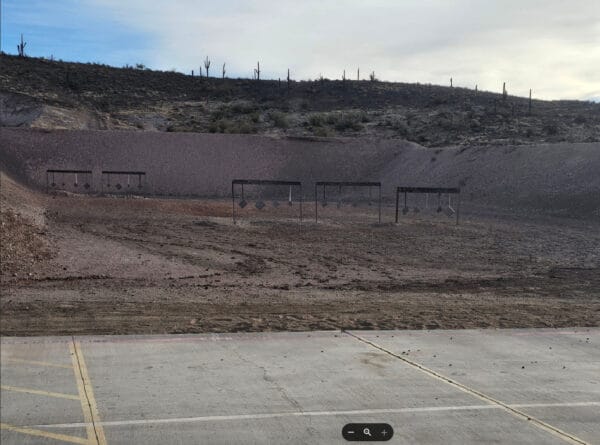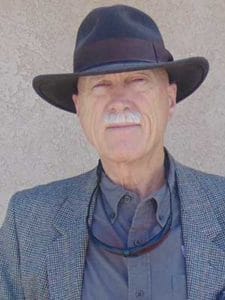
On January 4, 2025, President Joe Biden signed H.R. 6492, also known as the Explore Act. The Act contains H.R. 1614, the previous Range Access Act. The act, as passed, requires bureaucrats in the Bureau of Land Management (BLM) and the United States Forest Service (USFS) to consider the establishment of a target shooting range in each National Forest district or Bureau of Land Management (BLM) district. This is not a difficult requirement.
In Arizona, there are only four BLM districts. Each district is much larger than some of the smaller eastern states. BLM recently constructed three shooting ranges north of Phoenix, Arizona. These ranges were constructed before the Explore Act. The current rules on these ranges are extremely restrictive.
The experience of long-term desert shooters with the building of three ranges on BLM land north of Phoenix is a cautionary tale. A significant amount of money was spent to build well-designed ranges that have minimal utility.
The only shooting allowed at the ranges is shooting at steel targets at fixed distances, mostly at long ranges. No shooters are allowed to go down range. The only targets that may be used are the steel targets provided at the fixed ranges. The steel targets are painted once a week. This does not appear to be the original plan put forward by stakeholders when they met with BLM planners prior to the construction of the ranges.
Here is a slide show/video supplied by Tony Urso showing what experienced desert shooters expect of a range open to the public. The show is about 11 minutes long. It is very well done.
The use of steel targets in fixed positions, along with the prohibition against shooters from going down range in front of the firing line at any time, prevents many normal and expected uses of public ranges. Chronographs are generally not usable because most need to be placed ahead of the firing line. Shooting at close targets under 25 yards is not possible. Testing ammunition/firearms for accuracy is extremely limited because a shooter cannot determine where they hit the target with precision. Shooting to sight in a rifle or pistol is virtually impossible for the same reason.

Steel targets were chosen as a method to prevent people from going downrange. From the blm.gov/blog:
Because the sites are operated as self-service shooting facilities, they need special management to ensure public and staff safety. Each of the sites has steel targets installed to prevent visitors from going downrange to place their own targets.
Shooters are not allowed to paint the provided steel targets.
Here is a video presentation from the Bureau of Land Management showing how the targets are made. It shows a glimpse of the BLM ranges north of Phoenix.

Tony Urso noted that when these ranges were opened, about 4000 acres of land suitable for recreational shooting adjacent to the now official ranges were closed to the public as a “safety measure.” Local managers have the authority to regulate adjacent lands for safety reasons.
BLM states an estimated 71,000 visits were made in 2023 to the 4 BLM constructed ranges near Phoenix. There are three ranges to the north of Phoenix, west of Lake Pleasant, in a roughly north-south line about four miles long. The three sites are:
- Baldy Mountain Recreational Shooting Site
- Church Camp Road Recreational Shooting Site
- Saddleback Mountain Recreational Shooting Site
The Box Canyon Recreational Shooting Site is in Pinal County, southwest of the City of Maricopa. We would welcome reports from users of the Box Canyon site.
Sites are available six days a week, or about 312 days a year. The average estimated usage would be 71,000 divided by 4 X 312, or approximately 57 people per site per day. Some sites will be more popular than others. Weekends are probably more crowded than weekdays.
The lack of suitable facilities for pistol shooters is obvious. Pistols are designed for close-range use. Steel targets should not be shot at from close range because of the danger of backsplatter, bounce-back, and ricochet. Pistols are the most popular firearms purchased by the public.
All four sites ban shooters from going down range or from bringing their own targets. Those are site-specific rules which were not published in the federal register. The mandatory use of steel targets is a local rule that can be changed. It is a local prohibition arising from an over-abundance of caution, which precludes most traditional uses of ranges. These are the only public ranges this correspondent is aware of, which limit use to steel targets only to prevent shooters from going downrange.
The limitation of using only steel targets is an overreaction to potential dangers. The enabling legislation foresaw shooters would bring, set up, and remove their own targets. From the BLM site, rule 6:
You must only use authorized stationary targets as specified in the operating plan for each site. These targets may be made of cardboard, paper, self-healing, steel, and biodegradable clay (clay targets). All other items, such as aluminum cans, glass bottles, bowling pins, plastic bottles and other items which may leave debris, are not authorized to be used as targets. Exploding targets are prohibited. All user-supplied steel targets must be specifically designed for use with firearms and must be used at a distance of 100 yards or greater. Target frames must be designed to be reusable. The use of wooden pallets and other items not specifically designed as target frames are not authorized. All user-supplied targets, target frames, and debris must be removed from the site and disposed of properly after use and before leaving the site.
This correspondent’s experience as a bureaucrat leads to the question: was the decision to limit targets to provided steel targets primarily for the protection of the BLM decision makers? The idea seems to be that if you prohibit people from going down range, the liability of the decision-makers will be minimized. This is a pernicious idea which greatly diminishes the utility of the ranges. Thousands of people have been shooting on BLM land for decades. Accidents and injuries are minimal.
The idea of prohibiting people from safely going downrange to set up and remove targets is not a good innovation. The public BLM ranges should allow users to go downrange and use their own targets, especially for pistol shooting. Shooters at public ranges normally self-regulate this conduct by calling for a cold range to retrieve targets. Volunteers at public ranges could do the same.
As a shooter, this correspondent would have preferred less money spent on the installation of expensive chain link fencing on rough terrain. The money could have been used to provide for shade structures on the firing line. Shade, in Arizona summers, has high utility.
About Dean Weingarten:
Dean Weingarten has been a peace officer, a military officer, was on the University of Wisconsin Pistol Team for four years, and was first certified to teach firearms safety in 1973. He taught the Arizona concealed carry course for fifteen years until the goal of Constitutional Carry was attained. He has degrees in meteorology and mining engineering, and retired from the Department of Defense after a 30 year career in Army Research, Development, Testing, and Evaluation.

from https://ift.tt/qZ3N789
via IFTTT

No comments:
Post a Comment